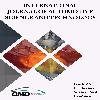Comparison of Common Deep Drawing Steel Sheets in terms of Blank Holder Force and Friction Conditions
Comparison of Common Deep Drawing Steel Sheets in terms of Blank Holder Force and Friction Conditions
Deep Drawing, Steel Sheet, Drawing Ratio, Blank Holder Force Coefficient of Fric-tion, Finite Element Analysis,
___
- Groover, M.P., (2016). Fundamentals of modern manufac-turing: materials, processes, and systems, Sixth ed. John Wiley & Sons, Inc., Hoboken, NJ.
- Vahdat, V., Santhanam, S., Chun, Y.W., (2006). A numeri-cal investigation on the use of drawbeads to minimize ear formation in deep drawing. J Mater Process Tech 176.
- Yagami, T., Manabe, K., Yamauchi, Y., (2007). Effect of alternating blank holder motion of drawing and wrinkle elim-ination on deep-drawability. J Mater Process Tech 187, 187-191.
- Chengzhi, S., Guanlong, C., Zhongqin, L., (2005). Deter-mining the optimum variable blank-holder forces using adap-tive response surface methodology (ARSM). Int J Adv Man-uf Tech 26, 23-29.
- Kitayama, S., Natsume, S., Yamazaki, K., Han, J., Uchida, H., (2016). Numerical investigation and optimization of pul-sating and variable blank holder force for identification of formability window for deep drawing of cylindrical cup. Int J Adv Manuf Tech 82, 583-593.
- Anonymous, (2017). Erdemir Sheet Metal Catalog. Ereğli Iron and Steel Factory.
- MSC Software Corporation, (2015). Simufact.forming 14.0, Izmir.
- Yayın Aralığı: 4
- Başlangıç: 2016
- Yayıncı: Otomotiv Mühendisleri Derneği
CFD Analysis of a Backward Facing Step Flows
Thabit THABİT, Senan THABET, Yaser JASİM
Numerical Modeling of Flashing Sprays Using a Hybrid Breakup Model
Yağmur GÜLEÇ, Alvaro DIEZ, Francesco CONTINO
Mushtaq Ahmad RATHER, Mohammad Marouf WANİ
Heat Transfer Correlations on Combustion Chamber Surface of Diesel Engine - Experimental Work
